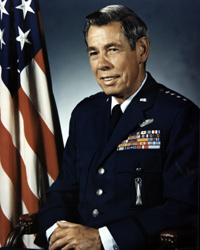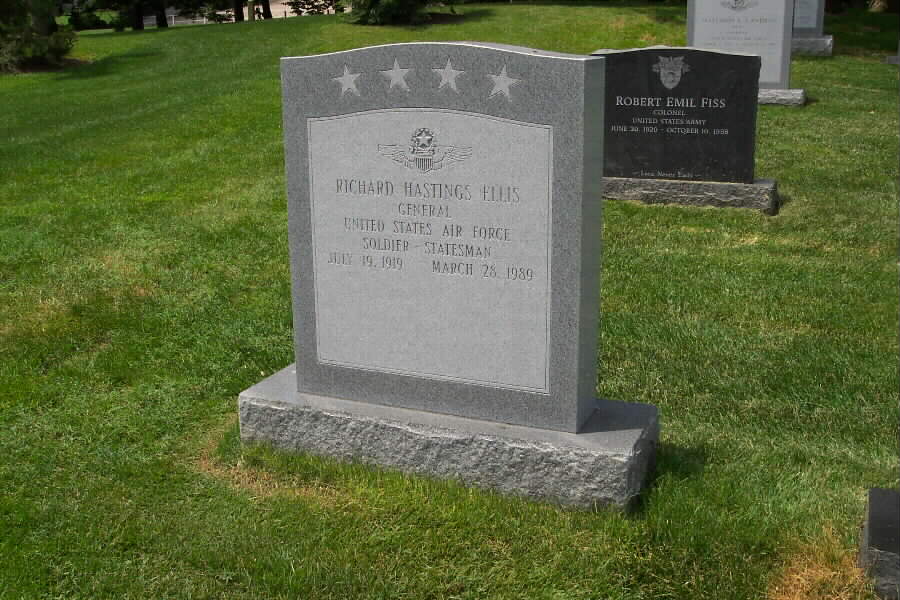Richard Hastings Ellis, 69, a retired Air Force General and commander of the Strategic Air Command from 1977 to 1981, died of cancer March 28, 1989 at Malcolm Grow Hospital at Andrews Air Force Base.
General Ellis retired from the Air Force after his service as chief of the Strategic Air Command, and the following year was appointed US representative to the Standing Consultative Commission, a US-Soviet body established in 1972 that meets twice yearly to discuss problems arising out of arms control agreements between the two countries. He served in that position until his death.
He was born in Wilmington, Delaware, and graduated from Dickinson College. During World War II, he served in the Army Air Forces as a bomber pilot based in Australia, New Guinea and the Philippines, and he participated in more than 200 combat missions.
After the war, Gen Ellis graduated from Dickinson School of Law, then practiced law in Wilmington. He was recalled to active duty with the Air Force in 1950 and served at Langley Air Force Base in Virginia and in England before becoming chief of the air plans and operations section at Supreme Headquarters Allied Powers Europe.
In 1958 General Ellis was assigned to the directorate of plans at Air Force headquarters in Washington, then in 1961 became executive to the Air Force chief of staff. Subsequent duty included command of the 315th Air Division at Tachikawa Air Base in Japan, command of the 9th Air Force based in South Carolina, vice commander in chief of US Air Forces in Europe, command of the 6th Allied Tactical Air Force in Turkey, command of Allied Air Forces in Southern Europe and command of the 16th Air Force in Spain. Gen Ellis was Air Force vice chief of staff, commander of Allied Air Forces in Central Europe and commander in chief of US Air Forces in Europe before he was named to the Strategic Air Command.
His decorations included the Distinguished Service Cross, Distinguished Service Medal with four oak leaf clusters, Legion of Merit with two oak leaf clusters, Distinguished Flying Cross and a Purple Heart.
General Ellis lived in McLean, Virginia, and had been a resident of the Washington area since 1958. Survivors include his wife, Margaret Parry Wolcott Ellis of McLean; two children, Richard Hastings Ellis Jr. of Fairfax and Mary Elsie Shea of New Orleans; a stepson, Josiah Oliver Wolcott III of Willits, Calif.; a brother, Dr. Wilbur Pierce Ellis of Laurel, Del., and two grandchildren.
General Ellis was buried with full military honors in Section 7-A, Grave 103-D, Arlington National Cemetery.
Courtesy of the United States Air Force
GENERAL RICHARD H. ELLIS
Retired August 1, 1981, Died March 28, 1989
United States Air Force Photo
General Richard H. Ellis was commander in chief of the Strategic Air Command and director of the Joint Strategic Target Planning Staff with headquarters at Offutt Air Force Base, Nebraska. He is also director of the Joint Strategic Connectivity Staff. SAC is the nation’s major nuclear deterrent force, with bombers, tankers, reconnaissance
aircraft and intercontinental ballistic missiles. The command’s mission also includes responsibility for space surveillance and missile warning systems. The Joint Strategic Target Planning Staff coordinates United States nuclear war plans and develops the Single Integrated Operational Plan. The Joint Strategic Connectivity Staff analyzes strategic connectivity systems and procedures and ensures the compatibility and commonality of the strategic command, control and communications systems.
General Ellis was born in Laurel, Delaware, where he completed elementary and high school. He received his bachelor of arts degree in history from Dickinson College, Carlisle, Pennsylvania, in 1941 and juris doctor degree from Dickinson School of Law in 1949. He was awarded an honorary doctor of science degree from Dickinson
College in 1961; honorary doctor of laws degrees from Dickinson School of Law in 1974, from the University of Akron (Ohio) in 1979, and from the University of Nebraska, Omaha, in May 1981.
The general entered active military duty in September 1941 as an aviation cadet at Maxwell Field, Alabama. He received his commission and pilot wings at Turner Field, Georgia, in April 1942.
During World War II he served with the 3rd Bombardment Group in Australia, New Guinea and the Philippines, and flew more than 200 combat missions in the Western Pacific area. He served as a pilot, squadron commander, group operations officer and, from September 1944, as group commander. In April 1945 General Ellis was assigned as deputy chief of staff, Far East Air Forces, in the Philippine Islands and Japan.
He requested release from active duty, became a member of the Air Force Reserve and entered Dickinson School of Law in 1946. He graduated in 1949 and, after admission to the Delaware Bar, practiced law in Wilmington, Del. He was recalled to active duty in October 1950 and assigned first to Headquarters Tactical Air Command, Langley Air Force Base, Virginia; then as deputy for operations, 49th Air Division, Sculthorpe, England; and later as chief, Air Plans and Operations Section, Supreme Headquarters Allied Powers Europe.
From January 1956 to May 1958, General Ellis was deputy chief of staff, operations, Headquarters 19th Air Force, Foster Air Force Base, Texas. He was then assigned to the Directorate of Plans, Headquarters U.S. Air Force, Washington, D.C., first as chief, Weapons Plans Branch, then as assistant director of plans for war plans, and later as assistant director of plans, joint matters.
In July 1961 General Ellis become executive to the chief of staff, U.S. Air Force. From August 1963 to June 1965, he commanded the 315th Air Division, Tachikawa Air Base, Japan. He returned to Washington, D.C., and served as deputy director, J-5 (Plans and Policy), with the Joint Staff. In August 1967 he returned to the Air Staff, this time as director of plans. He assumed command of 9th Air Force with headquarters at Shaw Air Force Base, South Carolina, in September 1969.
He was appointed vice commander in chief of U.S. Air Forces in Europe in September 1970. General Ellis become commander, 6th Allied Tactical Air Force, with headquarters at Izmir, Turkey, in April 1971; and commander of Allied Air Forces, Southern Europe, with headquarters at Naples, Italy, in June 1972. He assumed additional duty as commander, 16th Air Force, Torrejon Air Base, Spain, in May 1973.
The general served as vice chief of staff, U.S. Air Force, from November 1973 to August 1975. He was then appointed commander, Allied Air Forces Central Europe, and commander in chief, U.S. Air Forces in Europe. He assumed his present command in August 1977.
General Ellis is a command pilot and wears the Master Missile and the Parachutist badges. He has been awarded the Distinguished Service Cross, Distinguished Service Medal with three oak leaf clusters, Silver Star, Legion of Merit with two oak leaf clusters, Distinguished Flying Cross, Air Medal with four oak leaf clusters, Purple Heart and Grand Officer of the Italian Republic. He was awarded the State of Delaware Distinguished Service Medal by Governor Bacon in 1946. In September 1980 he was presented the Air Force Association’s highest honor, the H.H. Arnold Award for significant contributions to national defense. As the recipient of this award he was also named as the association’s National Aerospace Man of the Year. General Ellis received the Korean Order of National Security Merit First Class (Tong Il Jang) on May 13, 1981, at the Korean Ministry of National Defense in Seoul. This award, the highest honor given by the Republic of Korea to a foreign military leader, was presented to the general for his important contributions to national defense of the Republic of Korea.
He was promoted to General November 1, 1973, with date of rank September 30, 1973.
ELLIS, RICHARD HASTINGS
Headquarters: U.S. Army Forces in the Far East, General Orders No. 125 (1945)
Citation:
The President of the United States takes pleasure in presenting the Distinguished Service Cross to Richard Hastings Ellis, Lieutenant Colonel (Air Corps), U. S. Army Air Forces, for extraordinary heroism in connection with military operations against an armed enemy while serving as Pilot of an A-20 Bomber in the 3d Bombardment Group (L), FIFTH Air Force, while participating in a bombing mission on 5 April 1945, against enemy surface targets in the Southwest Pacific Area.
On that date, Lieutenant Colonel Ellis was the lead pilot of a flight of three A-20 type planes en route to rendezvous with eighteen B-25’s for a strike on an enemy convoy comprising of one transport and five warships. A rendezvous was made with the fighter cover provided, but the B-25’s, unable to locate the convoy, did not appear.
Though faced with heavy odds and lacking sufficient planes to keep the warships engaged, Colonel Ellis ordered the attack. Coming in through intense anti-aircraft fire, he flew directly over the leading warship, attacked the transport at minimum altitude, and sank it with two direct hits. During this action his two wingmen attacked and scored a near miss on a flanking vessel.
In this flight, possibly the longest ever made by A-20 aircraft, Colonel Ellis accomplished his mission without losses. Through his gallant and intrepid actions in the face of grave danger, he personally sank a vessel carrying troops of the enemy. The gallantry and devotion to duty displayed by Lieutenant Colonel Ellis on this occasion have upheld the highest traditions of the military service and reflect great credit upon himself, the 5th Air Force, and the United States Army Air Forces.
Michael Robert Patterson was born in Arlington and is the son of a former officer of the US Army. So it was no wonder that sooner or later his interests drew him to American history and especially to American military history. Many of his articles can be found on renowned portals like the New York Times, Washingtonpost or Wikipedia.
Reviewed by: Michael Howard


